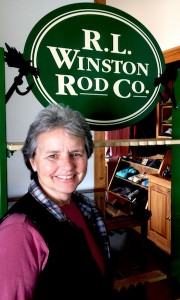 We’re beginning a new series on the blog to introduce you to some of the executive leadership here at Winston. Since the company began in 1929, there has been an uncompromising approach to creating the finest fly rods in the world.
We’re beginning a new series on the blog to introduce you to some of the executive leadership here at Winston. Since the company began in 1929, there has been an uncompromising approach to creating the finest fly rods in the world.
In this post, VP of Operations and Design Annette McLean shares the company’s perspectives on the design philosophy that shapes how each rod series is designed, prototyped, and tested before finding its way onto the racks of your favorite fly shop. She has been a part of virtually every stage and department related to rod manufacture and design: boron and graphite rod building, reel seat production, and bamboo rod building.
How long have you been with Winston Rod Company?
AM: I’ve worked for the Winston Rod Company for over 28 years. Tom Morgan hired me to buff and polish all the aluminum hardware for reel seats. At the time, Struble Manufacturing supplied us with the raw material and we would buff and polish the metal to prepare it for anodizing. Over the years, I’ve had the great fortune, to have some terrific teachers and supporters who have all played a role in whatever success I now enjoy.
As Co-Rod Designer, how has Winston’s philosophy about what makes the perfect rod shaped the understanding of the “Winston Feel”?
AM: The “Winston Feel” is a familiar phrase — something that has been attached to the company for many decades. It is definable and rests at the cornerstone of our design philosophy.
The “Winston Feel” is a progressive action that translates into a rod that is very easy for the angler to cast, allowing for accuracy at any casting distance and a smooth, progressive loading of the rod as the length of the cast is extended. This action doesn’t require a lot of strength, but it does ask the angler to relax rather than force the rod.
Winston’s approach to rod design is simple. Produce a lightweight, efficient, smooth casting rod that is a top performer on the water. Selecting that design parameter is the easy part. Getting the final design to live up to that expectation is a little more challenging.
How does Winston approach the design of a new rod? Does the company try to design a rod to meet specific performance parameters for a wide variety of fishing conditions or does Winston design a rod that performs best with a speciality application?
AM: Perhaps a little of both. When we begin the process of designing a new rod or rod series, establishing the expectations of the rod comes first. What are the fishing conditions that this new rod will be expected to handle? We match the rod design to the fishing conditions. The new Boron III LS series is a modern light line series. It’s designed for delicate, accurate presentations with longer light leaders and tippets. This series was designed with the intention of being very effective where slower line speed would be nice as you place a smaller fly in the area of a fish which has a PhD in artificial fly recognition, and gentle, accurate presentation is key.
Compare that scenario to one in which the angler needs to cast larger, wind-resistant flies to targets beyond 60 feet. In this case, the rod must be capable of handling a heavier load, controlling longer casts and have the ability to generate faster line speed. These were the parameters for the Boron III SX series.Given the differences in fishing applications for these two series, while each series maintains the same “Winston Feel”, design parameters for each series are clearly very different.
Look for Part II of this conversation with Annette in a few weeks!


